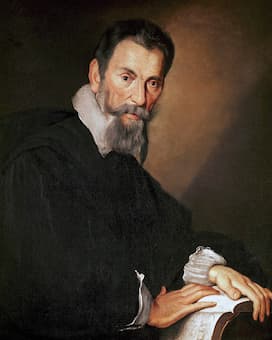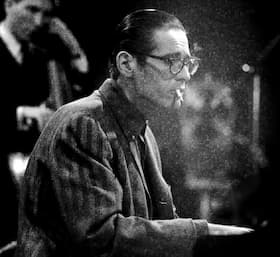
Berndardo Strozzi: Claudio Monteverdi (ca. 1630)
We were listening to a bit of Bill Evans the other day and something struck us as very familiar about it. We heard, of all things, an odd bass line, played very slow – descending. And then the trumpets came in – surely that was a bit of Monteverdi? That’s the tenor duet from the 9th book of madrigals! What was Bill Evans doing with music from the 1530s?

Bill Evans (1957)
Bill Evans’ 1957 composition On Green Mountain takes a virtuoso work by Monteverdi, the Zefiro torna, and makes it a virtuoso work for jazz ensemble. As performed at the Brandeis Jazz Festival in June 1957, it deconstructs Monteverdi’s work, starting with a slow introduction and then launches into a piece at an up-pace tempo. Even though the work is originally a duet, he starts with solo voices – tuba or trombone then trumpet – over that repeating bass line; it’s only when the trumpet launches into an improv section (3:47) that the second voice comes in. We never really get the duet as Monteverdi originally cast it – each voice remains a solo, although there may be some obbligato work or improvisation in another voice.
On Green Mountain – Bill Evans And Orchestra
Another jazz version of Zefiro torna, this time with voice for one part and soprano saxophone for other was created by jazz arranger Frank Vaganée.
Claudio Monteverdi: Zefiro torna e di soavi accenti, SV 251 (arr. F. Vaganée for voice and chamber ensemble) (Zefiro Torna; Frank Vaganée Jazz Trio)
In many ways this is a more successful version than Bill Evans’: the use of the vocal, even if for only one part, brings us closer to the original. The up-beat tempo also follows the Monteverdi versions following the ground-breaking recording by Nigel Rogers and Ian Partridge in 1972, where they took the work from something slow to something much more engaging.
Claudio Monteverdi: Scherzi musicali cioe arie et madrigali, SV 246-251: No. 7. Zefiro torna e di soavi accenti, “Ciaccona”, SV 251 (Ian Partridge, Nigel Rogers, tenors; Colin Tilney, harpsichord; Jürgen Jürgens, cond.)
Evans’ 1957 version follows the tradition of the recordings before the Partridge/Rogers recording, such as this in 1971 recording by Raymond Leppard, where the emphasis is on the operatic quality of the voice, rather than Monteverdi’s amazing ornamentation. Robert Tear was an opera singer better known for his roles in the operas of Benjamin Britten, than a singer in Renaissance styles.
Claudio Monteverdi: Madrigali e canzonette, Book 9: Zefiro torna e di soavi accenti, “Ciaccona”, SV 251 (Robert Tear, Alexander Oliver, tenors; Raymond Leppard, harpsichord)
This 2017 jazz version sounds like a better Renaissance / jazz combination, with the LeipJAZZig Orkester and the German Sjaella vocal sextet. Unfortunately, they leave off many of the runs and other ornamentation that is such an important part of this secunda prattica work. And the slow section is turned into a bit of Bach (Wir glauben all an einen Gott). So, perhaps 75% successful? One problem might be the use of the first word of the song, “Zefiro,” the name of the West Wind, as a chanting point – you’re not quite sure that they know what they’re saying.
LeipJAZZig-Orkester & Sjaella “Zefiro torna” Monteverdi / König
There are many more jazz versions out there – but most, in my opinion, are ultimately disappointing. It’s a pleasurable shock to hear it for the first time, but if you know the potential of the original work, these jazz versions are just so much surface, picking off what they can take and not delving deeper into the work in ways that would lead their own virtuosic playing.
For more of the best in classical music, sign up to our E-Newsletter

